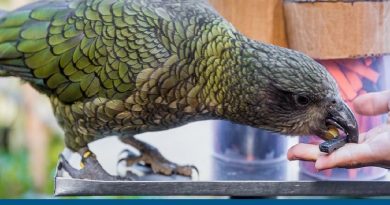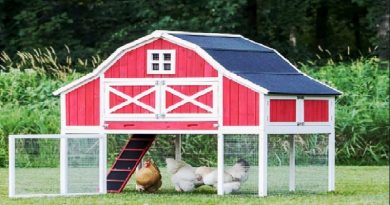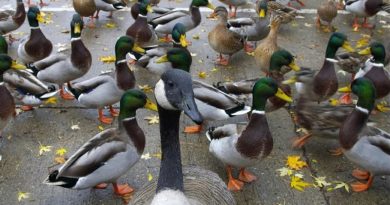20,000 Birds Just Starved To Death Off The Dutch Coast And No One Knows Why
20,000 Birds Just Starved To Death Off The Dutch Coast And No One Knows Why.
Birds are continuing to wash ashore and so far none of the obvious explanations can solve the mystery.A guillemot colony, very much alive.Thousands of seabirds have been washing onto the Dutch shoreline for about a month now. At least, we think it’s been a month. It’s unclear. Perhaps the most concerning detail is that no one really knows why.
This whole thing is “a bit of an enigma,” as Mardik Leopold, a biologist at Wageningen University who studies the ecology of the North and Wadden seas, puts it.
Leopold has been spearheading the efforts to figure out exactly why roughly 20,000 guillemots have died off the coast of the Netherlands (that’s an estimated 10,000 on beaches plus another 10,000 that are likely still at sea). So far there are a lot of theories and few answers. Starting with when this all began.
Leopold and his colleagues rely on a network of volunteers to comb the beaches and report when something unusual turns up. They initially received reports about an unusually high number of birds dying in early January just after a large container ship spilled some of its contents into the North Sea during a storm. But then again, “there are always dead birds on the beach in winter,” he says, so perhaps the volunteers heard about the container ship and started looking more closely right after. Either way, somewhere around the beginning of 2019, an unusually high number of guillemots began washing ashore on the northern coast. From there it seemed to spread (again, potentially because volunteers were alerted and started looking harder) down towards Rotterdam and into Zeeland.
But it stops at the border. “It’s a real Dutch problem,” Leopold says. Belgium isn’t seeing any elevated mortality to the south, and to the east Germany isn’t seeing much either. And it doesn’t seem to be slowing down. “I was on the beach yesterday in the storm and there are still new birds,” says Leopold. “We don’t know when this will stop.”
So far veterinary pathologists have autopsied around 16 birds. Rather than plastic pellets or any kind of poison, though, they’ve found empty stomachs. Instead, the guillemots have been emaciated, with no fat left on them—they’re starved to death. As for why, Leopold says there are a few theories.
First up: the weather. The classic explanation for a seabird wreck—that’s the technical term for when thousands of birds die like this without any apparent explanation—is prolonged bad weather. Even hardy seabirds like guillemots can’t withstand weeks on end of high wind. It wears them down, and unless there’s a lull, they can’t find enough food to replenish their body reserves. Leopold says guillemots are actually quite prone to wrecks for this reason. Long periods of wind have been known to kill tens of thousands of them before.
But the weather hasn’t been particularly bad. Leopold and colleagues compared weather data from this past December and January to the past 50 years and this winter hasn’t been especially cold or windy. Plus, he points out, it’s not like it could be windy only in the Netherlands and not in Belgium or Germany. “Guillemots are everywhere—they’re like bacteria,” Leopold says. “So you start suspecting that there’s a local factor.”
Next piece of potential evidence: the container spill. Plenty of plastic has been washing ashore from the ship disaster, but it’s mostly been far too large for a bird to swallow, like dolls and barstools. Besides, Leopold says, guillemots aren’t the kind of seabird that gobbles up little floating plankton that are likely to mistake plastic pellets for food.
So perhaps the ship spilled something chemical that’s killing the birds instead. But then why only guillemots? A poison in the water should be killing other seabirds. It could also be that there’s some chemical that’s getting into their food supply, maybe something only guillemots are eating. “The problem with that is that guillemots aren’t very specialistic feeders in winter,” Leopold says. They eat a wide variety of fish that plenty of other species consume as well.
Last up: paraffin. Terschelling, an island off the northern coast of the Netherlands, has seen some paraffin (a waxy solid made from petroleum, coal, or shale oil and used in things like cosmetics and polishings) wash ashore along with contents from the container ship accident. Some have speculated that the guillemots might have died eating that, not plastic. Because it’s fatty, yet not very digestible, paraffin can clog up the intestines and kill you. But Leopold says guillemots don’t eat fat the way seagulls do, so though it’s possible a starving bird might turn to paraffin in desperation this theory doesn’t seem likely either. Still, paraffin is one of the things the veterinarians plan to test for when they do more autopsies.
More likely than not, Leopold notes, the answer lies somewhere in the middle of all of these theories.
Next week, a whole group of experts—biologists, toxicologists, virologists, and pathologists—are going to gather to collectively examine about 100 birds sampled from all over the country. They’ll autopsy the guillemots, take whatever samples they need, then all head back to their respective labs to begin testing. Leopold hopes they’ll have some answers next month. In the meantime, he’s fielding inquiries and requests from people and scientists all over the world who are interested in this colossal mystery. “This is really snowballing,” Leopold says. “The newspapers and politicians are looking over our shoulders and they all want answers yesterday. But testing takes time.”
Source:https://www.popsci.com/guillemots-death-dutch-coast-why#page-3
You might also like:
==>Bleeding Heart Dove – Blood Run Down Bird Breast
==>ANDEAN CONDOR – The Largest Birds In The World
==>Driver Spots Bald Eagle And Start Recording. Then Quickly Realizes Something’s Wrong




